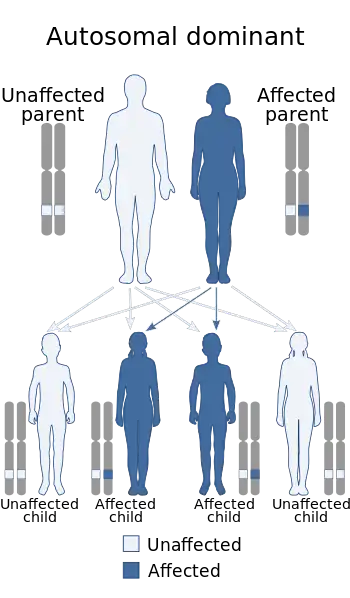Erythrokeratodermia variabilis
| Erythrokeratodermia variabilis | |
|---|---|
| Other names: Progressive symmetric erythrokeratodermia, Gottron type | |
 | |
| Erythrokeratodermia variabilis is inherited in an autosomal dominant manner of inheritance | |
| Usual onset | Infancy |
Erythrokeratodermia variabilis (also known as "erythrokeratodermia figurata variabilis", "keratosis extremitatum progrediens", "keratosis palmoplantaris transgrediens et progrediens",[2]: 509 "Mendes da Costa syndrome",[3] "Mendes da Costa type erythrokeratodermia", and "progressive symmetric erythrokeratoderma") is a rare autosomal dominant disorder that usually presents at birth or during the first year of life.[4] To date, it is thought to be caused by mutations in genes encoding for connexin channels proteins in the epidermis, leading to the misregulation of homeostasis in keratinocytes.[5]
One type is characterized by generalized, persistent, brown hyperkeratosis with accentuated skin markings, while a second type is localized, with involvement that is limited in extent and characterized by sharply demarcated, hyperkeratotic plaques.[2][6]: 565
It can be associated with GJB3[7] and GJB4.[8]It was characterized in 1925.[9]
.png.webp)
See also
References
- "OMIM Entry - # 133200 - ERYTHROKERATODERMIA VARIABILIS ET PROGRESSIVA 1; EKVP1". omim.org. Archived from the original on 30 April 2017. Retrieved 3 September 2017.
- 1 2 Freedberg, et al. (2003). Fitzpatrick's Dermatology in General Medicine. (6th ed.). McGraw-Hill. ISBN 0-07-138076-0.
- ↑ Rapini, Ronald P.; Bolognia, Jean L.; Jorizzo, Joseph L. (2007). Dermatology: 2-Volume Set. St. Louis: Mosby. ISBN 978-1-4160-2999-1.
- ↑ Freedberg, et al. (2003). Fitzpatrick's Dermatology in General Medicine. (6th ed.). Page 497. McGraw-Hill. ISBN 0-07-138076-0.
- ↑ Richard, Gabriela. (2000). Exp Dermatol. Page 77-96. ISSN 0906-6705.
- ↑ James, William; Berger, Timothy; Elston, Dirk (2005). Andrews' Diseases of the Skin: Clinical Dermatology. (10th ed.). Saunders. ISBN 0-7216-2921-0.
- ↑ Richard G, Smith LE, Bailey RA, et al. (December 1998). "Mutations in the human connexin gene GJB3 cause erythrokeratodermia variabilis". Nat. Genet. 20 (4): 366–9. doi:10.1038/3840. PMID 9843209. S2CID 841727.
- ↑ Macari F, Landau M, Cousin P, et al. (November 2000). "Mutation in the Gene for Connexin 30.3 in a Family with Erythrokeratodermia Variabilis". Am. J. Hum. Genet. 67 (5): 1296–301. doi:10.1016/S0002-9297(07)62957-7. PMC 1288569. PMID 11017804.
- ↑ Mendes da Costa, S. Erythro- et keratodermia variabilis in a mother and a daughter. Acta Derm. Venerol. 6: 255-261, 1925.
| Classification | |
|---|---|
| External resources |
|